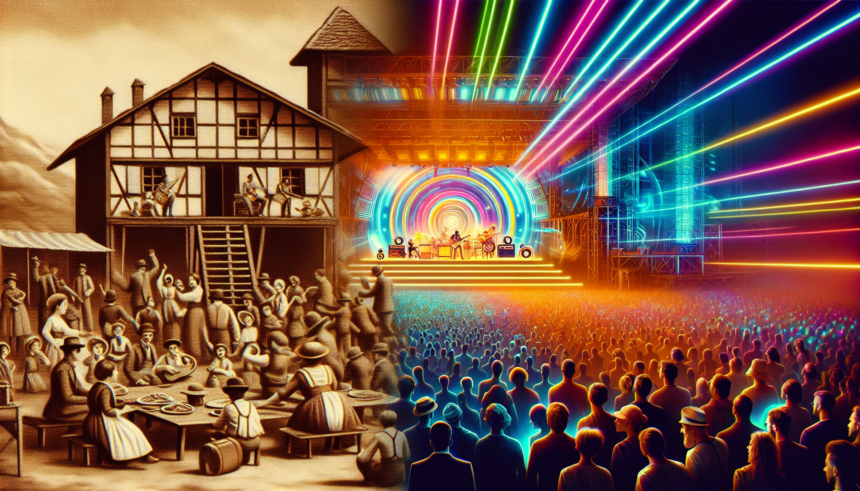Griasdi Festival, often heralded as a unique confluence of culture, music, and art, has evolved magnificently over the years. Originating from humble beginnings, the festival has metamorphosed into a global phenomenon, attracting enthusiasts from all corners of the globe. This article delves into the transformative journey of the Griasdi Festival, highlighting significant changes and milestones that have defined its rich history.
Origins and Early Days
The Griasdi Festival traces its roots back to a small community gathering aimed at celebrating local traditions, music, and cuisine. Initially held in a modest town square, the festival was primarily a family event, where locals would showcase their talents and heritage. During its nascent stage, the festival featured folk music, traditional dances, and home-cooked delicacies, providing a platform for the community to come together in a spirit of camaraderie.
Participation was limited, and the primary focus was on preserving and promoting the local culture. The performances were intimate, often involving live acoustic sessions and storytelling, where attendees could interact closely with the artists.
Expansion and Diversification
As word of the Griasdi Festival began to spread, the event started to attract visitors from neighboring towns and regions. This influx of new attendees encouraged the organizers to broaden the festival’s scope, incorporating diverse genres of music and arts. The inclusion of contemporary music, alongside traditional performances, marked a significant transformation in the festival’s identity.
During this phase, the festival grounds expanded to accommodate a larger audience, with makeshift stages, tents, and food stalls becoming a common sight. The festival began to feature an eclectic mix of performers, ranging from local bands to emerging artists from different parts of the country. This diversification not only enriched the cultural tapestry of the festival but also attracted a more varied demographic, including young music enthusiasts and art lovers.
Technological Advancements and Impact
The advent of technology had a profound impact on the evolution of the Griasdi Festival. From social media promotions to live streaming, technology played a crucial role in enhancing the festival experience and extending its reach to a global audience. Organizers embraced digital platforms to advertise the event, sell tickets, and engage with the audience more effectively.
Furthermore, advancements in sound and lighting technology elevated the quality of performances, providing artists with the tools to deliver more immersive and spectacular shows. The festival also introduced innovative features such as virtual reality experiences, interactive art installations, and digital art displays, adding a futuristic dimension to the traditional festival setup.
The integration of technology not only attracted tech-savvy attendees but also opened up new avenues for creative expression, allowing artists to experiment with multimedia performances and installations.
Globalization and International Appeal
The Griasdi Festival continued to grow in stature and popularity, eventually capturing the attention of the international community. Artists and performers from across the globe began to participate, bringing with them a myriad of cultural influences and artistic styles. This internationalization enriched the festival’s lineup, transforming it into a melting pot of global cultures and artistic expressions.
Collaborations between local and international artists became a hallmark of the festival, fostering cross-cultural exchanges and creating unique, fusion performances that captivated the audience. The festival also started to feature workshops, panel discussions, and cultural exchange programs, further enhancing its appeal as a hub of creativity and cultural dialogue.
Globalization not only elevated the festival’s profile but also attracted a diverse audience, including tourists, expatriates, and international media, cementing Griasdi Festival’s reputation as a world-class cultural event.
Ecological and Social Initiatives
In recent years, the Griasdi Festival has embraced a more sustainable and socially responsible approach, reflecting the growing global emphasis on environmental and social issues. Organizers have implemented various green initiatives, such as reducing single-use plastics, promoting recycling, and encouraging the use of eco-friendly materials throughout the festival grounds.
Additionally, the festival has partnered with local charities and community organizations to support social causes, such as education, healthcare, and poverty alleviation. By integrating these initiatives, the festival aims to create a positive impact on both the environment and the local community, aligning its celebrations with broader social and environmental goals.
Sustainability-themed art installations, educational workshops, and community-driven projects have become integral components of the festival, inspiring attendees to adopt and advocate for sustainable practices in their daily lives.
Adapting to Challenges and Future Prospects
Like many large-scale events, the Griasdi Festival has faced its share of challenges, particularly in the wake of global events such as the COVID-19 pandemic. The festival organizers have had to adapt swiftly, exploring alternative formats and virtual platforms to ensure the festival’s continuity and relevance.
The introduction of virtual festivals, hybrid events, and digital experiences has allowed the Griasdi Festival to reach audiences who might not be able to attend in person. These digital adaptations have not only provided a lifeline during challenging times but have also opened up new opportunities for innovation and expansion.
Looking ahead, the future of the Griasdi Festival seems promising. With a commitment to cultural diversity, technological innovation, and social responsibility, the festival is well-positioned to continue its legacy of excellence and inspiration. The integration of cutting-edge technologies, a focus on sustainability, and fostering global collaborations are likely to define the future trajectory of the festival, ensuring its relevance and appeal for generations to come.
Conclusion
The Griasdi Festival’s journey from a small, local gathering to a globally celebrated cultural phenomenon is a testament to its adaptability, innovation, and enduring appeal. By embracing change and fostering inclusivity, the festival has managed to stay relevant and captivating through the ages. As it continues to evolve, the Griasdi Festival promises to remain a vibrant and influential platform for artistic expression, cultural exchange, and community integration, inspiring future generations with its rich legacy and forward-thinking vision.
FAQs
1. When and where is the Griasdi Festival held?
The Griasdi Festival is typically held annually in the late summer. The exact dates and location may vary each year, so it is recommended to check the official festival website for the latest information.
2. How can I purchase tickets for the Griasdi Festival?
Tickets for the Griasdi Festival can be purchased online through the official festival website. Early bird discounts and group packages may also be available, so it is advisable to book your tickets in advance.
3. What types of performances and activities can I expect at the festival?
The Griasdi Festival features a diverse range of performances including music, dance, art installations, workshops, and cultural exchanges. Attendees can expect a mix of traditional and contemporary acts, as well as interactive experiences and educational activities.
4. Are there any accommodations available for festival-goers?
There are usually several accommodation options available for festival attendees, ranging from camping sites to nearby hotels and guesthouses. Details about accommodations can be found on the festival’s official website, along with booking information.
5. What measures are in place to ensure sustainability at the festival?
The Griasdi Festival has implemented various sustainability initiatives, including reducing single-use plastics, promoting recycling, and using eco-friendly materials. The festival also features sustainability-themed installations and workshops to educate and inspire attendees to adopt green practices.





